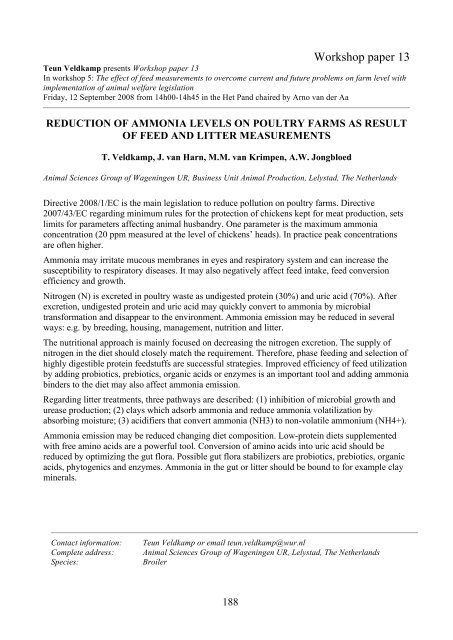Acknowledgements Book of abstracts - Publicaties - Vlaanderen.be
Acknowledgements Book of abstracts - Publicaties - Vlaanderen.be
Acknowledgements Book of abstracts - Publicaties - Vlaanderen.be
Create successful ePaper yourself
Turn your PDF publications into a flip-book with our unique Google optimized e-Paper software.
188<br />
Workshop paper 13<br />
Teun Veldkamp presents Workshop paper 13<br />
In workshop 5: The effect <strong>of</strong> feed measurements to overcome current and future problems on farm level with<br />
implementation <strong>of</strong> animal welfare legislation<br />
Friday, 12 Septem<strong>be</strong>r 2008 from 14h00-14h45 in the Het Pand chaired by Arno van der Aa<br />
REDUCTION OF AMMONIA LEVELS ON POULTRY FARMS AS RESULT<br />
OF FEED AND LITTER MEASUREMENTS<br />
T. Veldkamp, J. van Harn, M.M. van Krimpen, A.W. Jongbloed<br />
Animal Sciences Group <strong>of</strong> Wageningen UR, Business Unit Animal Production, Lelystad, The Netherlands<br />
Directive 2008/1/EC is the main legislation to reduce pollution on poultry farms. Directive<br />
2007/43/EC regarding minimum rules for the protection <strong>of</strong> chickens kept for meat production, sets<br />
limits for parameters affecting animal husbandry. One parameter is the maximum ammonia<br />
concentration (20 ppm measured at the level <strong>of</strong> chickens’ heads). In practice peak concentrations<br />
are <strong>of</strong>ten higher.<br />
Ammonia may irritate mucous membranes in eyes and respiratory system and can increase the<br />
susceptibility to respiratory diseases. It may also negatively affect feed intake, feed conversion<br />
efficiency and growth.<br />
Nitrogen (N) is excreted in poultry waste as undigested protein (30%) and uric acid (70%). After<br />
excretion, undigested protein and uric acid may quickly convert to ammonia by microbial<br />
transformation and disappear to the environment. Ammonia emission may <strong>be</strong> reduced in several<br />
ways: e.g. by breeding, housing, management, nutrition and litter.<br />
The nutritional approach is mainly focused on decreasing the nitrogen excretion. The supply <strong>of</strong><br />
nitrogen in the diet should closely match the requirement. Therefore, phase feeding and selection <strong>of</strong><br />
highly digestible protein feedstuffs are successful strategies. Improved efficiency <strong>of</strong> feed utilization<br />
by adding probiotics, prebiotics, organic acids or enzymes is an important tool and adding ammonia<br />
binders to the diet may also affect ammonia emission.<br />
Regarding litter treatments, three pathways are descri<strong>be</strong>d: (1) inhibition <strong>of</strong> microbial growth and<br />
urease production; (2) clays which adsorb ammonia and reduce ammonia volatilization by<br />
absorbing moisture; (3) acidifiers that convert ammonia (NH3) to non-volatile ammonium (NH4+).<br />
Ammonia emission may <strong>be</strong> reduced changing diet composition. Low-protein diets supplemented<br />
with free amino acids are a powerful tool. Conversion <strong>of</strong> amino acids into uric acid should <strong>be</strong><br />
reduced by optimizing the gut flora. Possible gut flora stabilizers are probiotics, prebiotics, organic<br />
acids, phytogenics and enzymes. Ammonia in the gut or litter should <strong>be</strong> bound to for example clay<br />
minerals.<br />
Contact information: Teun Veldkamp or email teun.veldkamp@wur.nl<br />
Complete address: Animal Sciences Group <strong>of</strong> Wageningen UR, Lelystad, The Netherlands<br />
Species: Broiler
















